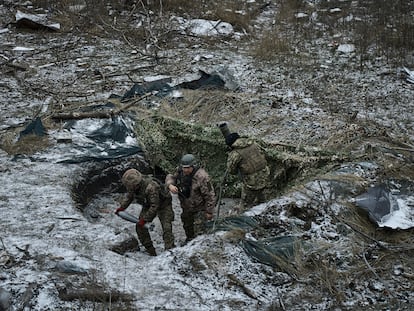Russia launches its ‘zombie’ soldiers against Avdiivka, the fiercest front in Ukraine
Moscow has been attacking the industrial city in the Donbas region for weeks with an all-out siege in which the number of casualties are of little consequence
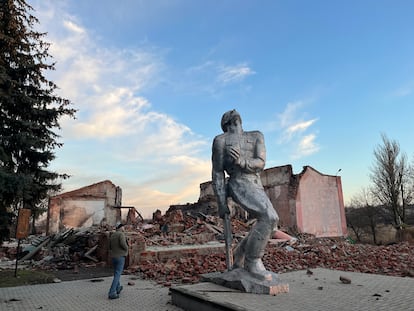

The apocalyptic image shows a field overgrown with weeds and littered with motionless bodies in green military uniforms. “They’re Russians, look at them,” Stella mutters. Some of the bodies rise after a few minutes. Most do not. “After that, others will come, and then more, like sleepwalkers. We see it every day,” says the soldier, serving with an aerial reconnaissance unit on the Avdiivka front in Donetsk province, the focus of the fiercest fighting in the Kremlin’s war against Ukraine. Russian forces have been pouring in like this for weeks, in waves, like zombies, against the industrial city of Avdiivka, an anthill of tunnels, factories, bunkers and trenches thrown up during the 2014 war in Donbas. Russia punishes it with constant shelling, as it did earlier in the war in the Battle of Bakhmut. Avdiivka today a heap of rubble, sinkholes, and buildings shattered by shells. Another frozen hell.
“It looks like they’re charging again,” spits Aleksandr, a sergeant in the 47th Separate Mechanized Brigade. The burly serviceman advances through the slimy, sticky Donbas mud toward one of his unit’s positions, a few kilometers from the besieged mining town, where a U.S. Paladin howitzer is operating. They have been stationed on the Avdiivka front for months, sinking in that mud. They are resisting the onslaught of Moscow’s troops, who are trying to pocket the town on the flanks to avoid the street fighting they faced in Bakhmut. The sergeant lights a cigarette. He cups his ear. “That [shot] was incoming,” he remarks. Shelling sounds nearby, but he doesn’t even blink.
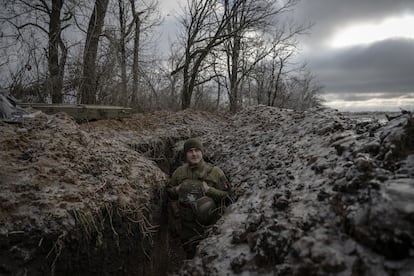
The 47th Brigade, like many others, is starved of ammunition. Their arsenals are depleted. They are fighting with what they have available, not always with what is best suited to hit their targets, Aleksandr acknowledges with a shrug. Kyiv hopes to receive more shells from its Western allies. The EU promised Ukraine one million artillery rounds, but has only managed to supply less than half and is still struggling to increase its industrial capacity to meet that commitment. Last Thursday, the U.S. announced another shipment - which may be the last for some time because of Republican reluctance to approve further aid packages - with various types of air defense, high-mobility artillery, and anti-armor ammunition.
Meanwhile, Russia has focused its war economy on the invasion. Western sanctions and isolation in the markets have not prevented the Kremlin from devoting most of its productive capacity to armaments. They make missiles in bread factories, assemble ammunition in tractor industries. They try at all costs to resupply themselves. Vladimir Putin has not shelved his goal of subduing Ukraine. His main war effort is now focused on capturing the entire Donbas region.
Ukrainian weapons, some of them supplied by its Western allies, are overstretched at many points on the front lines. “Russia does not have better weapons, but it has more materiel. And their strategy is to throw everything at us,” explains Yevgeni, one of the soldiers of the 47th, which was established with weapons such as U.S.-made M-2 Bradley and German Leopard 2 tanks, supplied by NATO allied countries. The Kremlin is firing artillery and drones of various types and employing frontal assaults, feigned attacks, and smoke to conceal the onslaughts. It is also closely guarding all roads to Avdiivka, where alongside Russian regular troops, convicts recruited to go to the front, and various contractors, a unit composed of ex-mercenaries of the Wagner Group is also fighting, according to Russian military bloggers.
In recent weeks, Russian forces have been laying mines, rendering roads and fields impassable for troops and the few remaining civilians in an area of eastern Ukraine that Putin said he wanted to liberate, and which is bearing the brunt of one of the worst periods of a full-scale war heading into its third year and carrying on its back the consequences of the Donbas conflict against Kremlin-supported separatists. For the hard-pressed people of the mining lands of eastern Ukraine, every day for a decade has been a new episode in an endless war.
Putin covets Avdiivka, once one of the heartlands of Donbas, as his next strategic piece. He attempted, unsuccessfully, to gain control of it in the 2014 war, through his pro-Russian separatist backers. Since then, the mining town, which had 32,000 inhabitants before the current invasion, has become one of Ukraine’s reinforced military strongholds. However, at immense human and material cost, Russia has managed to encircle it. A little further south, after a brutal siege, Moscow has taken control of the ruins of Marinka. Of what was once a town of 10,000 inhabitants before the war, with its schools, parks, and stores, only charred rubble remains.
According to a report by the Estonian Defense Ministry, the Kremlin managed to take more territory than it lost in 2023. However, none of those ruined enclaves conquered in the east and south represent a turning point that will tip the balance on the 1,300-plus-kilometer front line, which, after the Ukrainian counteroffensive stalled, has not changed significantly in a year.
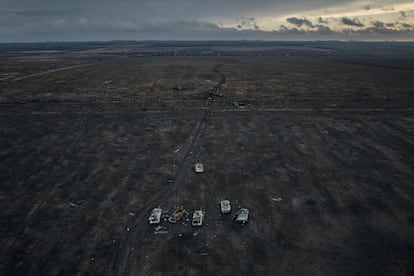
Ukraine is launching artillery strikes on the Avdiivka front to halt the Russian advance and the amphibious movement of its assault groups. Andrei, an almost six-foot-tall soldier of few words, has just recovered from a wound sustained in one of these assaults. He operates a heavy Soviet-made machine gun and was hit by Russian fire a month ago. He still has a piece of shrapnel in his back. “There it stays, as a souvenir,” he says with a shrug. After taking Marinka, the Russian assault on Avdiivka has spaced out a bit. On New Year’s Eve, Ukrainian President Volodymyr Zelenskiy visited the gateway to the city and some of its bunkers to decorate the servicemen stationed there. Meanwhile, Russia has increased its reserves in the area, according to Oleksandr Shtupun, spokesman for the Ukrainian General Staff.
Russian forces have been pushing for weeks to advance toward a coke mining plant, once among the largest in Europe and now another apocalyptic landscape. “The situation is difficult and we try to joke about everything,” says Sergeant Aleksandr. “Seeing how they are moving towards the plant, we make the joke that they are going to see how the coke is snorted. They don’t know what kind of coke they are looking for, they go there like drug addicts.”
Russia’s war against Ukraine has become a battle of attrition, of positions, where the Kremlin’s forces try to capture small pieces of ground regardless of the human cost. The UK intelligence agency claims that Russia is suffering its highest number of casualties so far in the war, mainly due to the bloody battle for Avdiivka. The British Ministry of Defense points out that the daily number of Russian casualties in Ukraine has risen by almost 300 over the course of 2023 and that if it continues at this rate, it will have lost more than half a million troops by the end of 2024. U.S. intelligence also claims that Russia executes retreating soldiers on the Avdiivka front.
Ukrainian forces have also suffered heavy losses. Neither Kyiv nor Moscow report casualty figures. Last week, during a rare press conference, the commander-in-chief of the Armed Forces of Ukraine, Valerii Zaluzhnyi, noted that for Russia the loss of life is not a variable for changing strategy, and admitted that it might come to the point where Ukrainian troops will be forced to retreat to positions outside Avdiivka. “The Ukrainian military will defend Avdiivka as long as they have the strength, but if they are not enough, it is important to save people,” he said. Kyiv’s strategy of holding Bakhmut for nine months under Russian siege at a very high cost, which also diverted forces from other positions, still weighs.
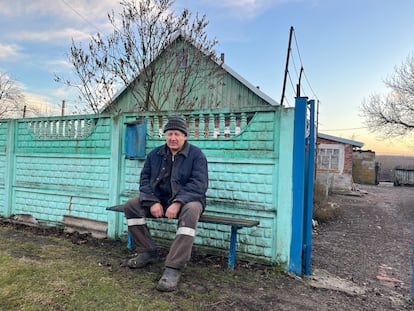
Meanwhile, Russian troops are advancing towards Novoselivka Persha, about 10 kilometers from Avdiivka, taking positions seven kilometers from the small town. Artillery thunders in a landscape already scarred by the Donbas war. In a small square, in front of the cultural center that Russian shelling destroyed a few weeks ago, a statue to a fallen Soviet soldier during the Second World War, which Russia calls the Great Patriotic War, stands intact. “Stupid bastards,” Anton Filipovich says. The man, who served in the Soviet Army next to the Baikonur Cosmodrome in Kazakhstan, looks through the gate of his house and sits on the bench in the driveway. He shakes his head: “I don’t like all this. Putin is a real asshole. I don’t understand why he’s attacking us. Doesn’t he have enough land?”
Sign up for our weekly newsletter to get more English-language news coverage from EL PAÍS USA Edition
Tu suscripción se está usando en otro dispositivo
¿Quieres añadir otro usuario a tu suscripción?
Si continúas leyendo en este dispositivo, no se podrá leer en el otro.
FlechaTu suscripción se está usando en otro dispositivo y solo puedes acceder a EL PAÍS desde un dispositivo a la vez.
Si quieres compartir tu cuenta, cambia tu suscripción a la modalidad Premium, así podrás añadir otro usuario. Cada uno accederá con su propia cuenta de email, lo que os permitirá personalizar vuestra experiencia en EL PAÍS.
¿Tienes una suscripción de empresa? Accede aquí para contratar más cuentas.
En el caso de no saber quién está usando tu cuenta, te recomendamos cambiar tu contraseña aquí.
Si decides continuar compartiendo tu cuenta, este mensaje se mostrará en tu dispositivo y en el de la otra persona que está usando tu cuenta de forma indefinida, afectando a tu experiencia de lectura. Puedes consultar aquí los términos y condiciones de la suscripción digital.
More information
Archived In
Últimas noticias
Maduro pleads not guilty before the federal court in New York: ‘I am still the president of Venezuela’
A new test can detect Alzheimer’s from a finger prick
UN team enters Sudanese city of El Fasher after paramilitary massacre: ‘It’s like a ghost town’
A recipe for resistance: Indigenous peoples politicize their struggles from the kitchen
Most viewed
- Gilles Lipovetsky: ‘If you want to live better and fall in love, take Prozac, don’t look to philosophy’
- Alain Aspect, Nobel laureate in physics: ‘Einstein was so smart that he would have had to recognize quantum entanglement’
- Alvin Hellerstein, a 92-year-old judge appointed by Bill Clinton, to preside over Maduro’s trial in New York
- Why oil has been at the center of Venezuela-US conflicts for decades
- Maduro’s downfall puts China’s relationship with Venezuela to the test

